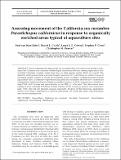Files in this item
Assessing movement of the California sea cucumber Parastichopus californicus in response to organically enriched areas typical of aquaculture sites
Item metadata
| dc.contributor.author | Van Dam-Bates, Paul | |
| dc.contributor.author | Curtis, Daniel L. | |
| dc.contributor.author | Cowen, Laura L. E. | |
| dc.contributor.author | Cross, Stephen F. | |
| dc.contributor.author | Pearce, Christopher M. | |
| dc.date.accessioned | 2019-06-20T09:30:01Z | |
| dc.date.available | 2019-06-20T09:30:01Z | |
| dc.date.issued | 2016 | |
| dc.identifier | 259356551 | |
| dc.identifier | c192da04-d8d0-49aa-b8b0-a2414ab7d64f | |
| dc.identifier | 85055019677 | |
| dc.identifier.citation | Van Dam-Bates , P , Curtis , D L , Cowen , L L E , Cross , S F & Pearce , C M 2016 , ' Assessing movement of the California sea cucumber Parastichopus californicus in response to organically enriched areas typical of aquaculture sites ' , Aquaculture Environment Interactions , vol. 8 , pp. 67-76 . https://doi.org/10.3354/aei00156 | en |
| dc.identifier.issn | 1869-215X | |
| dc.identifier.uri | https://hdl.handle.net/10023/17931 | |
| dc.description | Funding was provided by Fisheries and Oceans Canada’s Aquaculture Collaborative Research and Development Program, Viking Bay Ventures and the Klahoose Shellfish Limited Partnership. | en |
| dc.description.abstract | An increasing global demand for sea cucumbers has led to interest in benthic ranching of the California sea cucumber Parastichopus californicus beneath existing aquaculture sites in British Columbia, Canada, where high levels of total organic matter (TOM) are typical. The objective of the present study was to investigate movement of P. californicus in relation to areas of increased organic content to assess the feasibility of sea cucumber ranching beneath existing aquaculture sites. A laboratory experiment using adult sea cucumbers showed that P. californicus changed their foraging behaviour based on available amounts of TOM, moving more randomly in high-TOM (~8.0%) areas and more directly in low-TOM (~1.4%) ones. They also moved more rapidly in areas with high TOM than in those with low TOM. As long as animals were exposed to high TOM, they did not abandon random movement. Because of this behaviour, aquaculture tenures may retain a population of cultured individuals, but could also attract wild individuals from the surrounding area. | |
| dc.format.extent | 485715 | |
| dc.language.iso | eng | |
| dc.relation.ispartof | Aquaculture Environment Interactions | en |
| dc.subject | Aquaculture | en |
| dc.subject | California sea cucumber | en |
| dc.subject | Foraging | en |
| dc.subject | Movement | en |
| dc.subject | Parastichopus californicus | en |
| dc.subject | Sea ranching | en |
| dc.subject | Holothurian | en |
| dc.subject | QA Mathematics | en |
| dc.subject | QH301 Biology | en |
| dc.subject | SH Aquaculture. Fisheries. Angling | en |
| dc.subject | NDAS | en |
| dc.subject | SDG 14 - Life Below Water | en |
| dc.subject.lcc | QA | en |
| dc.subject.lcc | QH301 | en |
| dc.subject.lcc | SH | en |
| dc.title | Assessing movement of the California sea cucumber Parastichopus californicus in response to organically enriched areas typical of aquaculture sites | en |
| dc.type | Journal article | en |
| dc.contributor.institution | University of St Andrews. Statistics | en |
| dc.identifier.doi | 10.3354/aei00156 | |
| dc.description.status | Peer reviewed | en |
This item appears in the following Collection(s)
Items in the St Andrews Research Repository are protected by copyright, with all rights reserved, unless otherwise indicated.

